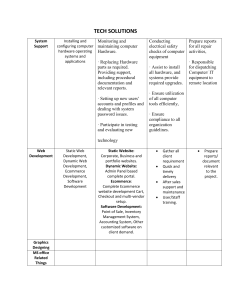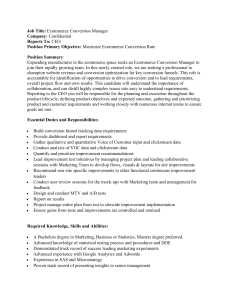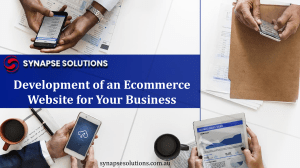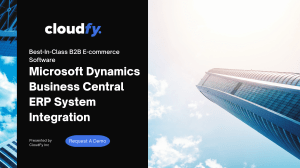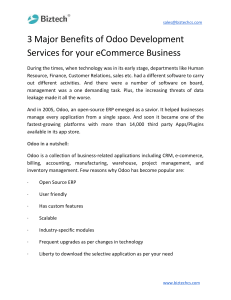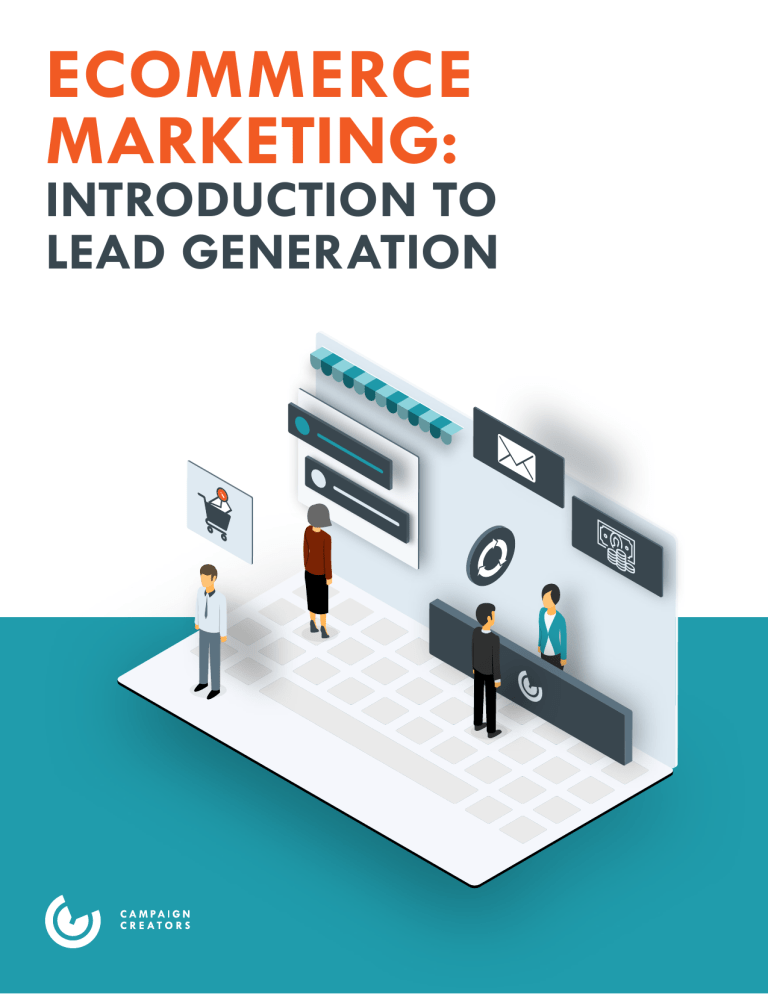
ECOMMERCE MARKETING: INTRODUCTION TO LEAD GENERATION Introduction 03 Defining Lead Generation 04 Qualifying a Lead 08 The Mechanics of Lead Generation 13 Worksheet: Starting Your First Campaign 21 Next Steps 26 You might think about throwing money at the problem with more retargeting and paid advertising—but there’s a less expensive and more lucrative strategy you should consider instead: ECommerce Lead Generation. Not only can Lead Generation help you increase sales, but it will also help you decrease your customer acquisition cost. CAMPAIGNCREATORS.COM Sure, you might be thinking—isn’t Lead Generation a B2B play? The answer is yes. But it’s also an invaluable tactic for eCommerce shops. Large or small, your eCommerce business should be developing a lead generation strategy if you want to reach consumers in today’s digital world. 3 INTRODUCTION As an eCommerce company, it’s common to only focus on driving traffic to your site, whether that’s with PPC ads, social media, or other available channels. But as far as your business bottom line, how many of those visitors end up making a purchase? DEFINING LEAD GENERATION What is an eCommerce lead? Let’s start with the basics. A lead is a person in your database who indicates an interest in your company’s product or service by performing a certain behavior. They haven’t purchased your product or service just yet, but an eCommerce lead may have given you their email for a 15% off discount or free product sample. Marketers in the eCommerce industry often don’t identify contacts in their database as leads, but this is a big mistake. According to Moz, retail sites typically don’t capture leads at the top or middle of the funnel—only once a shopper has checked out do they get added to the list. Historically, the buying cycle has been short enough for eCommerce sites to convert visitors to customers in a single visit. However, today’s consumer behavior has completely changed due to a number of factors we’ll discuss later. By identifying and capturing leads that haven’t made a purchase yet, you create an opportunity to convince those leads to purchase from you later. What is eCommerce lead generation? Lead generation is the process of attracting and capturing potential customers (aka your leads) that have shown interest in your company. This is typically done by collecting their email address. 4 For one, email marketing is the most effective way to continue and control conversations. Other marketing platforms, such as Instagram and Google, are becoming more difficult to use as they continue changing their algorithms. Also, email is a dependable marketing channel that isn’t going away any time soon. According to Statista, email usage is predicted to grow by 2-3% each year from 2018 to 2023. CAMPAIGNCREATORS.COM But why email addresses? A few ways eCommerce companies implement lead generation into their marketing strategy is by: ᇢ Offering a discount on a product or service ᇢ Creating a quiz related to their product or service ᇢ Creating exclusive content only for email subscribers ᇢ Offering a guide that educates visitors on how to best use a product ᇢ Providing a free consultation for their service Why do eCommerce companies need lead generation? According to BigCommerce, the average eCommerce conversion rate is a mere 2%. This means of all the people who visit your site, about 98% are likely to leave before making a purchase. If you don’t have any lead generation strategies to capture visitors who aren’t ready to make a purchase, then you may be missing out on hundreds or thousands in sales. Imagine your average order value (AOV) is $25, and you normally convert 2% of the 1,000 visitors that arrive on your site each day. If you increase the conversions by even 1%, you could increase your sales by a whopping $91,250 per year. To summarize, here are the three main reasons you need lead generation. 5 As more competition rises in your industry, the more likely shoppers will choose other brands over yours. By strategically capturing visitors who may not be ready to make a purchase, you’ll be able to continue conversations and have your brand stay top of mind when they are ready to buy. CAMPAIGNCREATORS.COM 1. It helps you stay competitive. 2. It adapts to today’s consumer shopping behavior. Shopping behavior has completely changed. Long gone are the days when a shopper looking for new shoes does a quick Google search, clicks on the first listed link, and purchases that exact pair of shoes. Instead, shoppers have more options and online resources to learn more about different products. A shopper today may read hours of product reviews or ask for a friend’s opinion prior to making a purchase decision. Because most visitors aren’t purchasing on their first visit, lead generation helps you capture and identify valuable contacts that may purchase later. 3. It will reduce your customer acquisition costs. 6 CAMPAIGNCREATORS.COM Many eCommerce companies struggle with rising customer acquisition costs due to online marketing becoming more competitive and expensive. With a proper lead generation strategy in place, you’ll be able to counter rising acquisition costs and still implement a highly effective marketing strategy that drives new customers. Ultimately, eCommerce companies need to incorporate lead generation if they want to build a sustainable marketing strategy that adapts to today’s consumers. Lead generation also supports the inbound marketing methodology, also known as modern marketing. Source: HubSpot Inbound marketing is a business methodology that attracts customers by creating valuable content and experiences tailored to them. Outbound marketing tends to interrupt your audience with content they’re not interested or ready for. This methodology consists of four main stages: attract, convert, close, and delight. 7 CAMPAIGNCREATORS.COM Lead generation falls in the second stage of inbound marketing—this is the convert stage where visitors are turned into leads. As you can see in the diagram, generating leads is a fundamental step in an individual’s journey to becoming a delighted, repeat customer. QUALIFYING A LEAD What is lead qualification? Lead qualification is the process of identifying and categorizing the different types of contacts you capture. Not every lead will be ready or interested in purchasing your product, so qualifying your leads will help you understand who to focus your time and energy on. In lead generation, this typically happens during the initial conversion where additional information is collected to better learn about that lead. For example, an online shoe shop may offer a discount in exchange for filling out a form. This form may ask for their email, as well as their favorite shoe style. By understanding what that new lead is interested in, you will be able to segment and qualify them. How do you qualify a lead? Qualifying a lead can vary depending on the offer. The most common way eCommerce companies qualify leads is by asking questions through forms and quizzes. Visitor intent: Discover the lead’s reason or goal for visiting your website. ᇢ Purchase readiness: Understand whether your lead is ready to buy, or not. ᇢ Product-specific preferences: Especially if you offer different styles for a specific product, find out what your lead prefers. ᇢ Interest in other product/service: If you have other products or services, understand if they’re interested in them as well. Uncovering this information about your new lead requires a combination of strategy and creativity. Be mindful that the more valuable the offer, the more information leads are willing to provide. 8 ᇢ CAMPAIGNCREATORS.COM For starters, you can begin by uncovering any of these four elements about your new lead: Let’s take a look at how Warby Parker is able to uncover this information in their frames quiz. This is a great example of how you can capture and qualify a lead in one offer. 1. Visitor intent - What are you looking for? 9 CAMPAIGNCREATORS.COM Warby Parker has a number of different products, but they strategically begin the quiz by asking a simple question. This helps qualify a lead’s basic intentions and goals of landing on their site. 2. Purchase readiness - Do you wear glasses? Warby Parker asks this question in order to understand their lead’s experience and knowledge with their product. By knowing this, this can also uncover how far their lead is in their buyer’s journey. 10 CAMPAIGNCREATORS.COM Understanding a lead’s purchase readiness helps with segmenting and identifying those that are likely to purchase sooner rather than later. 3. Product-specific preferences - Which shapes do you like? Similar to the first two questions, the answer provided will help you identify and segment your lead. The only difference is that these questions give the user the ability to skip the question if they have no preference. This option should only be provided for questions that would be helpful to know, but are not necessary. 11 CAMPAIGNCREATORS.COM Making these types of questions optional can improve the user’s experience and increase conversions (aka completion of the form) if they can’t give you that information. 4. Interest in other product/service - Want sunglasses recommendations too? If you have other products or services, this is a great opportunity to identify whether the user is interested or even aware of them. This is essentially an opportunity to cross-sell. Warby Parker is widely known for their eyeglasses, but they use this question to determine if their visitor is interested in sunglasses as well. 12 CAMPAIGNCREATORS.COM Warby Parker ends the quiz by asking for the participant’s email in order to generate and save the quiz results. Not only did this quiz capture a new lead, but it also discovered a lot of valuable information to help segment and qualify that lead in their database. THE MECHANICS OF LEAD GENERATION Now that you understand the importance of lead generation for eCommerce companies, let’s discuss what this process and campaign looks like. A lead generation campaign can vary in complexity, however, you can launch a full-functioning campaign with just four components. Let’s cover what each of those elements are and how this fits into the lead generation process. The Four Main Components of Lead Generation In order to illustrate the four main components, we’ll use HUM Nutrition’s offer as an example. Imagine you discover HUM Nutrition’s offer to receive 20% off and to get matched with the right product for you. This offer includes the first essential element, which is a… 1. Call-to-action (CTA). 13 CAMPAIGNCREATORS.COM A CTA is typically a button or linked message that encourages visitors to take a certain action. This linked CTA then takes that visitor to your... 2. Landing page. A landing page is a web page a visitor lands on for a distinct purpose. Some eCommerce companies use pop-ups strategically as well that can serve as a landing page. While a landing page or pop-up can be used for various reasons, one of its most frequent uses is to capture leads through a… 3. Form. Forms are hosted on landing pages and pop-ups. They consist of at least one email field and can include a series of fields that collect additional information in exchange for an ... An offer is the content or something of value that’s being offered on the landing page. The offer must have enough value to a visitor to merit providing their personal information in exchange for it. In the example above, HUM Nutrition is providing a personal nutrition report, access to an RD Nutritionist, effective product combinations, and a $10 off coupon code. After your visitor enters their information and clicks the final submit button on the form, or in this case, enters their email and clicks next, the visitor has successfully become a lead. 14 CAMPAIGNCREATORS.COM 4. Offer. Some offers, such as HUM Nutrition’s quiz, may require more information and next steps. If your offer requires asking additional questions, remember that the more questions you ask, the less likely your visitor will complete the process. 15 CAMPAIGNCREATORS.COM HUM Nutrition does a great job by first capturing the visitor’s email before even starting the quiz. If the lead happens to fall off or leave the quiz incomplete, they can still follow-up with that lead because they have their email. 6 Places to Promote Your Marketing Offers for Lead Generation Now that you understand the four main components of turning a visitor into a lead on your landing page, you must be thinking, how do I get visitors to my offer in the first place? This is where promoting your offers on different marketing channels come in. While there are various channels, below are six of the quickest and most effective ways you can start driving traffic to your offer. 1. Relevant Website Pages Promote your offer on website pages that align with the goal of that page. For example, a product summary page will list multiple products at once. The goal of this page is to help online shoppers sift through multiple products and choose a product to purchase. Imagine you have a quiz that helps shoppers identify the right product for them. A product summary page is a great place to promote that offer because it can help visitors achieve their goal when on that page. Source: Blue Bottle Coffee 16 CAMPAIGNCREATORS.COM Here’s an example from Blue Bottle Coffee. On their coffee subscription page, they also provide a “Try It On Us” offer. Visitors that land on this page are likely interested in signing up for their Coffee Subscription, therefore a CTA enticing visitors to get a subscription for free aligns with the visitor’s intent. 2. On Your Blog Just about every blog post you publish should have a CTA. Again, try to align the content of the offer with the content of the blog post as best as you can. This ensures that you’re strategically promoting your offer to the right audience. See how West Elm places their offer and CTA in the middle of the blog post. It’s also best practice to link the CTA at the very end of the blog as a “next step” offer once the visitor is done reading your blog post. 17 CAMPAIGNCREATORS.COM Source: Front + Main (West Elm Blog) 3. On Your Social Media Accounts Sharing on social media is an easy and cost-effective way you can promote your offers. Describe the value that fans and followers will receive, and make sure to include your offers landing page link. Try to vary the timing of when you share certain offer’s so people who follow you on multiple social sites aren’t hit with the same promotion on each site. 4. Within Press Releases If your business uses news releases as a way to promote information about your business, don’t overlook the opportunity they provide for lead generation. Just as you’d use anchor text (text that is visible and clickable in a hyperlink) in a blog post to point to a landing page, do the same in your news releases. BONUS: You’ll likely reap some SEO benefits from this practice, as well! 18 CAMPAIGNCREATORS.COM See Pressed Juicery’s example below, promoting an offer on their Instagram channel to receive a free juice in exchange for your cellphone number. What’s great is they outlined how to receive this offer both in the image and in the caption. They even took extra steps to let their potential leads know they will receive automated marketing text messages after signing up. 5. In PPC Campaigns Think of your PPC ads as CTAs for your offers. What’s great about PPC ads is that you have the ability to tailor them to specific audiences based on demographics, activity, behavior, and more. Note that PPC campaigns aren’t cheap, so make sure you have the budget to execute your paid ads effectively. 19 CAMPAIGNCREATORS.COM Below you’ll find a paid Facebook Ad by Candid promoting their free 3D scan offer. Once an interested visitor clicks on this ad, they are then taken to a landing page to provide their email and additional information, turning that visitor into a new lead. 6. Influencer Marketing Similar to PPC campaigns, influencer marketing is one of the more expensive options for promoting your offers, yet it’s clear that they’ve become highly effective for eCommerce businesses. According to Mediakix, 80% of marketers say influencer marketing is effective, and 89% say it works just as well (if not better) than other marketing channels. There’s a variety of influencers you can hire, such as celebrities, bloggers, social media influencers, or thought leaders. With each influencer, they can also promote your offer through a variety of channels, including on their personal social media accounts, to their email database, or on their podcast. 20 CAMPAIGNCREATORS.COM The key to successful lead generation with influencer marketing is choosing the right influencer to promote on the right channel. Make sure the influencer you choose has an audience that reflects your target audience. Specify that they promote your offer where your shoppers are most active. WORKSHEET: STARTING YOUR FIRST LEAD GENERATION CAMPAIGN Now that you’ve learned the rudiments of lead generation, you must be thinking... “How do I start my first lead generation campaign?” “How am I going to find time to build these marketing offers?” “Where do I even begin with all these best practices?” We get it. We’ve been through it. And we want to help you get started. Below, you’ll find the beginning of a lead generation worksheet. This worksheet outlines steps to follow and includes space for you to brainstorm your first eCommerce lead generation campaign. 1. Define your offer Whether this is a coupon, a quiz, or a free product sample, be mindful of the time and resources it may take to create each of these offers. Take advantage of existing content you may already have, such as blog posts or educational videos. Repurposing existing content can be an easy way to get your offer up fast. a. Type of offer: ___________________________________________________________________ b. The value: c. What will this look like?: ___________________________________________________________________ 21 CAMPAIGNCREATORS.COM ___________________________________________________________________ d. What resources do you need?: ___________________________________________________________________ e. Value of offer: ___________________________________________________________________ 2. Build your landing page & form Build a dedicated landing page for your offer. This landing page should include a clear headline of the offer, as well as outline the benefits of receiving this offer. Make sure to include a form that visitors will need to complete in exchange for the offer. a. Headline: ___________________________________________________________________ b. Summarize offer & benefits: ___________________________________________________________________ ___________________________________________________________________ ___________________________________________________________________ ___________________________________________________________________ 22 CAMPAIGNCREATORS.COM c. Questions to ask in form: d. Image ideas to use on landing page: ___________________________________________________________________ 3. Build your “thank you” page or email Provide a way for your leads to receive the offer by redirecting them to a thank you page where the offer is hosted, or by setting up an automated email that sends the offer right after filling out the form. a. How will this offer be delivered?: ___________________________________________________________________ b. Summarize your “thank you” copy: ___________________________________________________________________ ___________________________________________________________________ 4. Promote your offer Now that your offer is created and ready to download from your landing page, start promoting the landing page URL on your various promotional channels. a. List all the places you can promote your offer: ___________________________________________________________________ 23 CAMPAIGNCREATORS.COM ___________________________________________________________________ Social Tip Share your offer multiple times on your social channels by extracting different parts of it. For example, if you have 10 tips in the offer, share one tip a day. Blog Tip Write multiple blog posts that relate to the theme or topic of your offer. Every time you publish a post, you can add a CTA to your same offer in each published post. PPC Tip 24 CAMPAIGNCREATORS.COM Experiment with different targeting options on your PPC campaigns in order to use your offer in multiple ways. This will help you generate more leads while learning what works best. NEXT STEPS While lead generation is the key to fueling your eCommerce marketing engine, the next step is to turn your leads into customers. This is where lead nurturing comes in. If you’re ready to learn how to convert your leads into customers, check out our How To Create An ECommerce Lead Nurturing Guide so that you can learn: ᇢ How to create an eCommerce lead nurturing campaign in 5 steps ᇢ The 10 core elements of a sophisticated lead nurturing campaign ᇢ How to utilize a promotional calendar for continued nurturing GET MY GUIDE SHARE THE LOVE Created by: KARA SUSVILLA Marketing Associate ALEXA HUBLEY Digital Marketing Content Manager ALVARO FLORES Interactive Designer 8 58 .633.1915 campaigncreators.com
